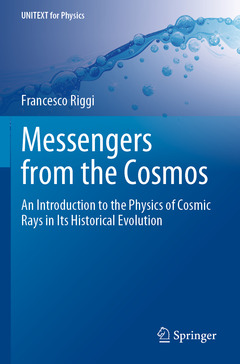Description
Messengers from the Cosmos, 1st ed. 2023
An Introduction to the Physics of Cosmic Rays in Its Historical Evolution
UNITEXT for Physics Series
Author: Riggi Francesco
Language: English
Subjects for Messengers from the Cosmos:
Keywords
cosmic rays; history of cosmic rays; Discovery of cosmic radiation; Extraterrestrial radiation; Cosmic ray pioneers; Cosmic ray detection techniques; Extensive air showers; Cosmic ray composition; Influence of Earth on cosmic rays; Influence of Sun on cosmic rays; Particle detector arrays; Muon interactions; Origin of cosmic rays; Cosmic ray applications; Muon tomography techniques; Particles from outer space; Messengers fom cosmos
Publication date: 05-2023
367 p. · 15.5x23.5 cm · Paperback
Publication date: 04-2023
367 p. · 15.5x23.5 cm · Hardback
Description
/li>Contents
/li>Biography
/li>Comment
/li>
This book provides a complete overview of the development of cosmic ray physics, with historical and educational considerations, from early evidence of the existence of extraterrestrial radiation up to the most recent applications of cosmic ray muons in different aspects of daily life.
Many of the original results that contributed to the study of cosmic radiation are presented and discussed, accompanied by bibliographic references, numerous in-depth appendices, about 200 illustrations and a large chapter dedicated to the overall impact of cosmic rays.
The book includes sections on, among other topics: the debate on the corpuscular or radiative nature of cosmic radiation; the development of early techniques for detecting cosmic particles; the properties and composition of primary and secondary radiation; and the interaction of cosmic muons in matter and a long list of their recent applications, ranging from the muon tomography techniques to the investigation of the stability of civil buildings.
The book is addressed to a wide audience, and thus, while it is used for introductory cosmic ray physics courses at the bachelor's or master's level, high school students and teachers involved in educational projects around cosmic rays also benefit from its many historical and educational aspects.
Francesco Riggi has been full professor of Experimental Nuclear and Particle Physics in the Department of Physics and Astronomy at the University of Catania, Italy. He has been working in nuclear physics at low and high energy since 1974 and joined, at its inception, the ALICE Collaboration, a large experiment at the CERN Large Hadron Collider to study nuclear matter under extreme conditions. Within the ALICE Collaboration, he has contributed to the construction of the electromagnetic calorimeter and the silicon pixel detector, investigating the production of multistrange particles, short-lived resonances and light (anti)nuclei.
He has also been active in studying the physics of cosmic rays over the last 20 years, leading several projects concerning the use of cosmic muons in tomographic applications, and has served as a member of the educational project EEE, operating a wide network of cosmic ray telescopes. He is the author or the co-author of more than 600 scientific papers in all such areas and has contributed to various international conferences, as well as acting as a referee for various journals of nuclear and applied physics. He has also spent various periods abroad for research, in several European countries, the USA and Australia. As a professor at the Department of Physics and Astronomy in Catania, he has taught several courses in general and nuclear physics for 40 years. He is also the co-author of a textbook in experimental physics.
Presents the original results that led to our understanding of cosmic radiation
Covers a wide range of applications of cosmic muons
Includes over 200 illustrations and 14 appendices




